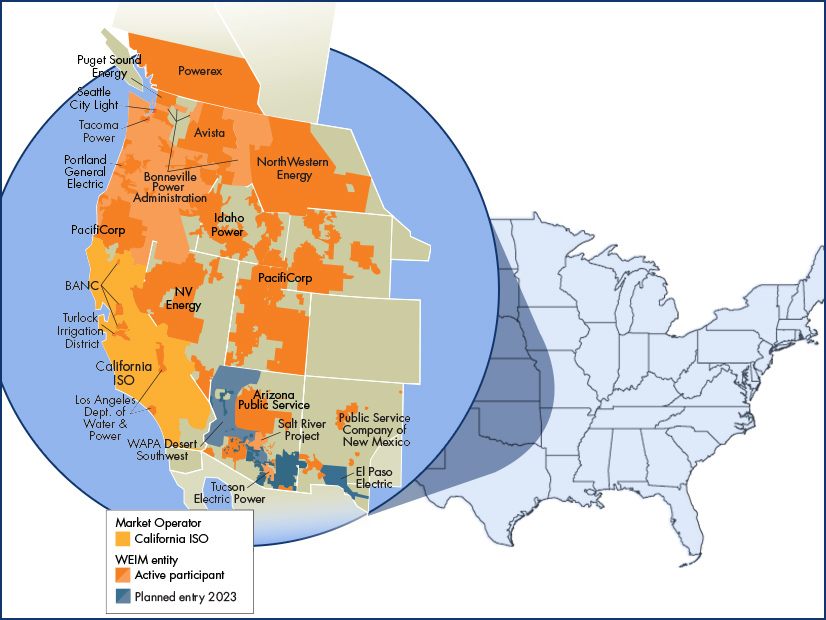
CAISO issued a revised straw proposal last week for its planned day-ahead expansion of the Western Energy Imbalance Market, currently a real-time market that covers large portions of 10 states and one Canadian province.
The updated proposal, released Aug. 16, adds provisions on transmission commitment, resource sufficiency and firm energy contracts following a series of technical workshops and stakeholder meetings to iron out differences on the more difficult issues.
“This revised straw proposal for the extended day-ahead market (EDAM) reflects significant stakeholder input and design changes from the initial April 28, 2022, straw proposal,” the ISO said. (See CAISO Issues EDAM Straw Proposal for the West.)
Among the major changes are refinements to the EDAM’s proposed transmission commitment framework.
The initial straw proposal stated that unsold, firm available transfer capability (ATC) should be offered by EDAM participants to support transfers between balancing authority areas (BAAs) in the West.
An EDAM entity would be expected to “make available all remaining unsold firm ATC at an intertie with an adjoining EDAM BAA” by 10 a.m. in the day-ahead market and to stop open-access transmission tariff sales of firm ATC at the intertie between 10 a.m. and 1 p.m. while the day-ahead market was running, it said.
 The EDAM could extend across much of the territory now included in the WEIM’s real-time market. | CAISO
The EDAM could extend across much of the territory now included in the WEIM’s real-time market. | CAISO
Stakeholders and the ISO, however, did not settle on some specifics of the plan.
The revised straw proposal says that “unsold transmission by the transmission provider will be made available to the market hurdle-free. Transmission customers can voluntarily release transmission rights for EDAM optimization, and the ISO will allocate transfer revenue associated with those rights directly to the transmission customer.”
“The design also includes a proposed mechanism for transmission providers to recover potential foregone transmission revenues resulting from their participation in EDAM. This seeks to keep transmission providers as whole as possible from a transmission revenue recovery perspective.”
Resource Sufficiency
The proposal for a resource sufficiency evaluation (RSE) in the EDAM was left partially incomplete in April. The RSE test is intended to keep participants from leaning on the market for internal capacity needs, but consequences for failing the test — one of the most controversial issues in the EDAM stakeholder process so far — were not delineated in the first straw proposal.
Stakeholders had discussed financial penalties and transfer limits but did not reach agreement.
“Although there was no consensus regarding a particular approach, stakeholders generally preferred some form of financial consequence for failure, rather than a complete freezing of transfers in the day-ahead time frame, which could be detrimental to reliability,” the straw proposal said.
After multiple technical workshops, the revised straw proposal “focuses on an administrative surcharge[s] under all conditions to incentivize meeting the RSE. It also introduces mechanisms to address ISO [load-serving entities’] concerns regarding their discretion to manage supply above what the ISO needs to meet its RSE to better manage grid reliability challenges if conditions change between day-ahead and real-time.”
Firm Energy Contracts
The revised proposal also introduced a “tagging mechanism,” a means of electronically monitoring and recording an energy transaction, for firm energy contracts.
In a firm energy contract, the “supplier takes on the obligation to deliver the generation and make the necessary transmission arrangements” to get the supply to the purchasing or sink BAA, but “neither the source of the generation (or source BAA), nor the transmission path is known by the time of the day-ahead market (10 a.m.) when bids into the market are due.” That information “becomes known later,” it said.
“In a day-ahead market context, the lack of source specificity and transmission path pose a challenge in modeling the expected flows across the system,” it said. “Nevertheless, the ISO recognizes these arrangements are an important source of supply in the West today.”
Uncertainties about source and transmission require a tagging mechanism to “provide greater confidence in these arrangements,” it said. “Intertie bids at the ISO border that are under contract to an ISO LSE or otherwise have a contract under the ISO tariff will be eligible for the ISO RSE and will also be subject to the tagging requirements.”
Additional Features
Other provisions in the revised straw proposal include:
- a convergence bidding proposal that maintains a one-year transition period to convergence bidding for EDAM entities. “After that first year, the EDAM entity will have the option to adopt convergence bidding in their area or elect for another year of transition,” it says. “After the second transition year, an EDAM entity would be expected to transition to convergence bidding, absent any findings that doing so poses adverse outcomes.”
- an equal sharing of transfer revenues “across all interfaces between EDAM BAAs, subject to commercial arrangements that may require exceptions. In addition, in instances where congestion arises from an internal intertie constraint enforced within a BAA, the ISO will allocate the congestion revenue fully to the BAA where the constraint is modeled.”
- a greenhouse gas accounting and reporting protocol in which the EDAM will start with a “resource specific approach to GHG accounting because this is a known, implementable approach that California ISO builds upon and enhances the current WEIM framework. Throughout this initiative, however, we will continue to vet and evaluate the alternate approaches.”
- an EDAM administrative fee arrangement under which a “systems operations charge will be applied to metered flows in megawatt-hours of supply and demand. This is a similar assessment to the grid management charge system operations charge.”
Meetings to discuss the revised straw proposal are scheduled for Aug. 29 (virtual only) and Sept. 7-8 (virtual and in person.) The EDAM stakeholder initiative webpage contains additional information on the upcoming meetings and anticipated EDAM development milestones.


